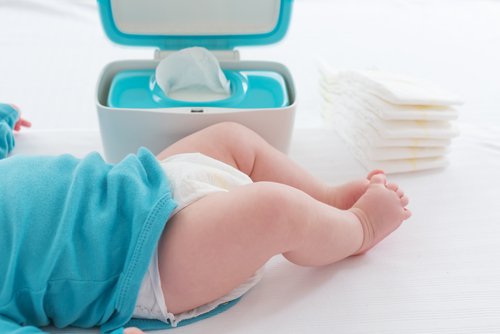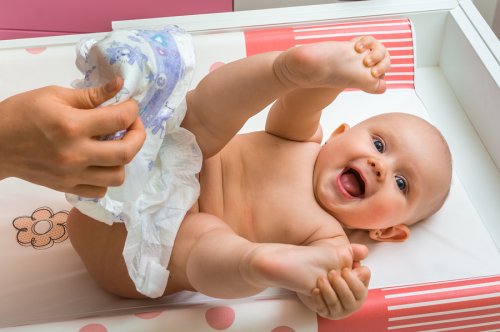When to Change the Size of Your Baby's Diaper?

Surely you know that there are many diaper options on the market, in different sizes and all with their various advantages. However, you may not have a clue when to change your baby’s diaper size. In this article, we’ll give you some keys so you can identify the ideal moment.
Tips about when to change the size of your baby’s diaper
The main diaper brands on the market have come in all shapes and sizes. There are even tiny diapers for premature babies or larger ones for those who take longer to go to the bathroom on their own. Most use the child’s weight to determine sizes, but these standards can change depending on the manufacturer.
Many times, it’s not easy to find the right size. Therefore, we’ll give you some tips on when to change the size of your baby’s diaper:
1. Small sizes are only for the first days
You0ll be amazed at how fast your baby grows. Even from the time your baby’s born to when you leave the hospital, you’ll see changes in your little one; this is normal in the first few weeks. To give you an idea, a six-month-old child is twice as big as when they were born.
Therefore, it is best to buy a small number of small size diapers, as they will last very little, even if you spend more than five a day. It is also common that the first diaper you put on him is not a small size, especially if he weighed more than 3.5 kg at birth.

2. There are many leaks
One of the main signs that it’s time to change the size of the baby’s diaper is that it doesn’t properly contain your child’s waste. When it overflows once, it may be because your little one has peed or pooped a lot, but if it happens continuously, it means that they need a bigger size. It’s not due to lack of absorption, but because of the fit!
3. Pay attention to the manufacturer’s instructions
In most cases, diapers have standard sizes, but that does not mean that there are no slight changes between each brand. The information on the package allows you to know what size is suitable for your baby according to their weight. A general table is as follows:
- Size N diapers <10 pounds
- Size 1 diapers 8-14 pounds
- Size 2 diapers 12-18 pounds
- Size 3 diapers 16-28 pounds
- Size 4 diapers 22-37 pounds
- Size 5 diapers >27 pounds
- Size 6 diapers >35 pounds
As you’ll see, the sizes overlap each other in weights. Therefore, you have to try which one suits your baby best. A tip: If, for example, your baby weighs 17 pounds, but is quite “long”, it’s better to buy size 3 (from 16 to 28 pounds) rather than a size 2 (from 12 to 18 pounds) so that it fits more comfortably.
“When it overflows once, it may be because your little one has peed or pooped a lot, but if it happens continuously, it means that they need a bigger size. It’s not due to lack of absorption, but because of the fit!”
4. Elastics and closures: A perfect fit
Another way to determine when it’s time to change your baby’s diaper size is by looking at how tight it fits. If the elastic areas of the legs leave marks on the skin, buy a larger size.
At the waist, the diaper should be comfortable enough not to squeeze your little one when they finish eating and allow them to move freely. Also, take a look at the closures: if they’re too far apart when closed or don’t reach the height of the baby’s navel, you probably need to move up to a larger size.

5. Signs in your baby’s body that show it’s time to change the size of your baby’s diaper
This is another way to know when it’s time to change the size of your baby’s diaper. Red spots on the legs or hips or hard-to-heal diaper rash can be prevented or reduced with a looser-fitting diaper.
If your baby is already a little older — around two years old — they may be able to tell you themself that they’re not comfortable in their diaper. For example, if they try to take it off, if they move it, or if their movements are too limited, you may have to consider buying them a larger size.
If you have doubts regarding the placement of the diaper, how often to change it, or what size is best for your baby, the best thing you can do is talk to your pediatrician. The professional will be able to guide you and recommend brands or sizes according to your child’s needs.
Surely you know that there are many diaper options on the market, in different sizes and all with their various advantages. However, you may not have a clue when to change your baby’s diaper size. In this article, we’ll give you some keys so you can identify the ideal moment.
Tips about when to change the size of your baby’s diaper
The main diaper brands on the market have come in all shapes and sizes. There are even tiny diapers for premature babies or larger ones for those who take longer to go to the bathroom on their own. Most use the child’s weight to determine sizes, but these standards can change depending on the manufacturer.
Many times, it’s not easy to find the right size. Therefore, we’ll give you some tips on when to change the size of your baby’s diaper:
1. Small sizes are only for the first days
You0ll be amazed at how fast your baby grows. Even from the time your baby’s born to when you leave the hospital, you’ll see changes in your little one; this is normal in the first few weeks. To give you an idea, a six-month-old child is twice as big as when they were born.
Therefore, it is best to buy a small number of small size diapers, as they will last very little, even if you spend more than five a day. It is also common that the first diaper you put on him is not a small size, especially if he weighed more than 3.5 kg at birth.

2. There are many leaks
One of the main signs that it’s time to change the size of the baby’s diaper is that it doesn’t properly contain your child’s waste. When it overflows once, it may be because your little one has peed or pooped a lot, but if it happens continuously, it means that they need a bigger size. It’s not due to lack of absorption, but because of the fit!
3. Pay attention to the manufacturer’s instructions
In most cases, diapers have standard sizes, but that does not mean that there are no slight changes between each brand. The information on the package allows you to know what size is suitable for your baby according to their weight. A general table is as follows:
- Size N diapers <10 pounds
- Size 1 diapers 8-14 pounds
- Size 2 diapers 12-18 pounds
- Size 3 diapers 16-28 pounds
- Size 4 diapers 22-37 pounds
- Size 5 diapers >27 pounds
- Size 6 diapers >35 pounds
As you’ll see, the sizes overlap each other in weights. Therefore, you have to try which one suits your baby best. A tip: If, for example, your baby weighs 17 pounds, but is quite “long”, it’s better to buy size 3 (from 16 to 28 pounds) rather than a size 2 (from 12 to 18 pounds) so that it fits more comfortably.
“When it overflows once, it may be because your little one has peed or pooped a lot, but if it happens continuously, it means that they need a bigger size. It’s not due to lack of absorption, but because of the fit!”
4. Elastics and closures: A perfect fit
Another way to determine when it’s time to change your baby’s diaper size is by looking at how tight it fits. If the elastic areas of the legs leave marks on the skin, buy a larger size.
At the waist, the diaper should be comfortable enough not to squeeze your little one when they finish eating and allow them to move freely. Also, take a look at the closures: if they’re too far apart when closed or don’t reach the height of the baby’s navel, you probably need to move up to a larger size.

5. Signs in your baby’s body that show it’s time to change the size of your baby’s diaper
This is another way to know when it’s time to change the size of your baby’s diaper. Red spots on the legs or hips or hard-to-heal diaper rash can be prevented or reduced with a looser-fitting diaper.
If your baby is already a little older — around two years old — they may be able to tell you themself that they’re not comfortable in their diaper. For example, if they try to take it off, if they move it, or if their movements are too limited, you may have to consider buying them a larger size.
If you have doubts regarding the placement of the diaper, how often to change it, or what size is best for your baby, the best thing you can do is talk to your pediatrician. The professional will be able to guide you and recommend brands or sizes according to your child’s needs.
All cited sources were thoroughly reviewed by our team to ensure their quality, reliability, currency, and validity. The bibliography of this article was considered reliable and of academic or scientific accuracy.
- Hernández, A. M. F. (2021). Prevención de la dermatitis irritativa del área del pañal en el niño en la consulta de Enfermería de Pediatría. Enfermería, 26(08). Disponible en: https://revistamedica.com/prevencion-dermatitis-irritativa-pediatria/
This text is provided for informational purposes only and does not replace consultation with a professional. If in doubt, consult your specialist.








